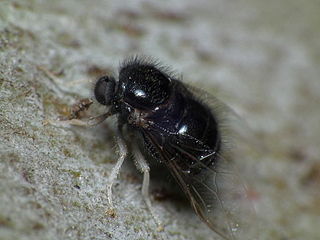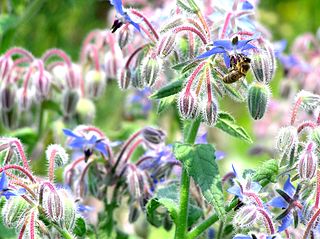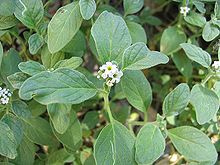
The Malvales are an order of flowering plants. As circumscribed by APG II-system, the order includes about 6000 species within nine families. The order is placed in the eurosids II, which are part of the eudicots.

Boraginaceae, the borage or forget-me-notfamily, includes about 2,000 species of shrubs, trees, and herbs in 146 to 156 genera with a worldwide distribution.

Hydrophylloideae is a subfamily of the plant family Boraginaceae. Their taxonomic position is somewhat uncertain. Traditionally, and under the Cronquist system, they were given family rank under the name Hydrophyllaceae, and treated as part of the order Solanales. More recent systems have recognised their close relationship to the borage family, Boraginaceae, initially by placing Hydrophyllaceae and Boraginaceae together in an order Boraginales, and most recently by demoting Hydrophyllaceae to a subfamily of Boraginaceae. However the placement and circumscription of Boraginaceae is still uncertain: it is unplaced at order level, and there is some prospect of it being split up again in future.

The family Campanulaceae, of the order Asterales, contains nearly 2400 species in 84 genera of herbaceous plants, shrubs, and rarely small trees, often with milky sap. Among them are several familiar garden plants belonging to the genera Campanula (bellflower), Lobelia, and Platycodon (balloonflower). Campanula rapunculus and Codonopsis lanceolata are eaten as vegetables. Lobelia inflata, L. siphilitica and L. tupa and others have been used as medicinal plants. Campanula rapunculoides may be a troublesome weed, particularly in gardens, while Legousia spp. may occur in arable fields.

Linaceae is a family of flowering plants. The family is cosmopolitan, and includes about 250 species in 14 genera, classified into two subfamilies: the Linoideae and Hugonioideae. Leaves of the Linaceae are always simple; arrangement varies from alternate to opposite or whorled. The hermaphroditic, actinomorphic flowers are pentameric or, very rarely, tetrameric.

Heliotropium is a genus of flowering plants in the heliotrope family, Heliotropiaceae. There are around 325 species in this almost cosmopolitan genus, which are commonly known as heliotropes. They are highly toxic to dogs and cats.

The Acroceridae are a small family of odd-looking flies. They have a hump-backed appearance with a strikingly small head, generally with a long proboscis for accessing nectar. They are rare and not widely known. The most frequently applied common names are small-headed flies or hunch-back flies. Many are bee or wasp mimics. Because they are parasitoids of spiders, they also are sometimes known as spider flies.

Boraginales is an order of flowering plants in the asterid clade, with a total of about 125 genera and 2,700 species. Different taxonomic treatments either include only a single family, the Boraginaceae, or divide it into up to eleven families. Its herbs, shrubs, trees and lianas (vines) have a worldwide distribution.

In biogeography, cosmopolitan distribution is the term for the range of a taxon that extends across all of the world, in appropriate habitats; most cosmopolitan species are known to be highly adaptable to a range of climatic and environmental conditions, though this is not always so. Killer whales (orcas) are among the most well-known cosmopolitan species on the planet, as they maintain several different resident and transient (migratory) populations in every major oceanic body on Earth, from the Arctic Circle to Antarctica and every coastal and open-water region in-between. Such a taxon is said to have a cosmopolitan distribution, or exhibit cosmopolitanism, as a species; another example, the rock dove, in addition to having been bred domestically for centuries, now occurs in most urban areas across the world.

Haloragaceae is a eudicot flowering plant family in the order Saxifragales, based on the phylogenetic APG system. In the Cronquist system, it was included in the order Haloragales.

Bourreria is a genus of flowering plants in the borage family, Boraginaceae. Members of the genus are commonly known as strongbark or strongback. The generic name was chosen by Patrick Browne to honour German pharmacist Johann Ambrosius Beurer. The genus is native to the Americas, where species are distributed from Mexico to northern South America, and in the Caribbean and Florida in the United States. The center of diversity is in the Caribbean, Central America, and Mexico.
Hoplestigma is a genus of flowering plants in the family Boraginaceae, although this is disputed, and it has been placed in its own family Hoplestigmataceae. Its two species are native to Cameroon, Gabon, Ivory Coast and Liberia in western tropical Africa.

Wellstedia is a genus of flowering plants traditionally included in the family Boraginaceae s.l., but placed in its own family, Wellstediaceae within the Boraginales order, by the Boraginales Working Group.

Boraginoideae is a subfamily of the plant family Boraginaceae s.s, with about 42 genera. That family is defined in a much broader sense in the Angiosperm Phylogeny Group (APG) system of classification for flowering plants. The APG has not specified any subfamilial structure within Boraginaceae s.l.
Heliotropiaceae are a cosmopolitan family of flowering plants with approximately 450 species worldwide, though it is concentrated especially in the tropics and subtropics.

Polyplacidae is a family of lice in the suborder Anoplura, the sucking lice. Lice in this family are known commonly as the spiny rat lice. The family has a cosmopolitan distribution. As of 2010 there were 193 species.

Coldenia, named after C. Colden, is a monotypic genus of flowering plants traditionally included in the borage family, Boraginaceae sensu lato. It was assigned to the subfamily Ehretioideae, but molecular data revealed it to be more closely related to the genus Cordia, so that other authors placed in Cordioideae. Subsequently, it was placed in its own family, Coldeniaceae, within the Boraginales order, by the Boraginales Working Group.

Euploca is an almost cosmopolitan genus of plants with around 100 species. It was first described by Thomas Nuttall in 1837. While part of the broadly defined Boraginaceae in the APG IV system from 2016, a revision of the order Boraginales from the same year includes Euploca in the separate family Heliotropiaceae. Its species used to be classified in the genera Hilgeria and Schleidenia and in Heliotropium sect. Orthostachys, but were found to form an independent lineage in a molecular phylogenetic analysis, more closely related to Myriopus than to Heliotropium. While many species use the C4 photosynthetic pathway, there are also C3–C4 intermediate species. Species have leaves with a C4-typical Kranz anatomy.
Euploca humilis, the dwarf tournefortia, is a species of flowering plant in the family Boraginaceae. It is native to Mexico, Central America, the Caribbean, Colombia, Venezuela, Guyana, and most of Brazil. Originally described by Linnaeus in 1753, molecular and morphological evidence led to its transfer from Tournefortia to Euploca in 2016.
















